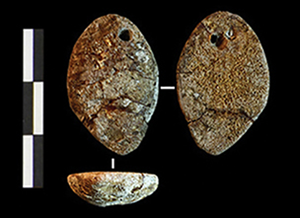Crossref Citations
This article has been cited by the following publications. This list is generated based on data provided by
Crossref.
Piličiauskas, Gytis
Simčenka, Edvardas
Lidén, Kerstin
Kozakaitė, Justina
Miliauskienė, Žydrūnė
Piličiauskienė, Giedrė
Kooijman, Ellen
Šinkūnas, Petras
and
Robson, Harry K.
2022.
Strontium isotope analysis reveals prehistoric mobility patterns in the southeastern Baltic area.
Archaeological and Anthropological Sciences,
Vol. 14,
Issue. 4,
Ahola, Marja
Holmqvist, Elisabeth
and
Pesonen, Petro
2022.
Materialising the Social Relationships of Hunter-Gatherers: Archaeological and Geochemical Analyses of 4th Millennium BC ‘Slate Ring Ornaments’ from Finland.
Journal of Archaeological Method and Theory,
Vol. 29,
Issue. 4,
p.
1259.
Jørgensen, Erlend Kirkeng
2023.
Technological organization and initial production stages of a maritime slate tradition: insights from the first investigated Stone Age slate source in Arctic Europe (the Djupvik slate formation, Norway).
Acta Borealia,
Vol. 40,
Issue. 1,
p.
46.
Ryazantsev, Pavel
Tarasov, Aleksey
and
Potakhin, Maksim
2023.
Archaeological prospection of a prehistoric lithic workshop site using ground penetrating radar with a high‐frequency antenna unit.
Archaeological Prospection,
Vol. 30,
Issue. 3,
p.
341.
Karmanov, Viktor N.
2023.
THE GARINO TRADITION OF BIFACIAL FLINT KNAPPING AND THE PROBLEM OF SEARCHING FOR ITS ORIGINS.
Rossiiskaia arkheologiia,
p.
20.
Petrović, Anđa
Macāne, Aija
Strautnieks, Ivars
Kalniņa, Laimdota
Holmqvist, Elisabeth
Hunter, Emily M.
Pomstra, Diederik
Goodchild, Helen
Villén, Ana Harto
Zagorska, Ilga
Edmonds, Mark
Nordqvist, Kerkko
and
Little, Aimée
2024.
Stone axes throw new light on Baltic stone age mortuary rites.
Scientific Reports,
Vol. 14,
Issue. 1,
Alenius, Teija Helena
Marquer, Laurent
and
Nordqvist, Kerkko
2024.
Exploring local and regional vegetation compositional changes during the Neolithic (5th–3rd millennium BC): A case study on the forager impact on vegetation in north-east Europe.
The Holocene,
Vol. 34,
Issue. 9,
p.
1304.
Bochkarev, Vadim Sergeevich
and
Poliakov, Andrei Vladimirovich
2024.
Encyclopedia of Archaeology (Second Edition).
p.
1.
Nordqvist, Kerkko
2024.
Encyclopedia of Archaeology (Second Edition).
p.
672.
Zeng, Tian Chen
Vyazov, Leonid A.
Kim, Alexander
Flegontov, Pavel
Sirak, Kendra
Maier, Robert
Lazaridis, Iosif
Akbari, Ali
Frachetti, Michael
Tishkin, Alexey A.
Ryabogina, Natalia E.
Agapov, Sergey A.
Agapov, Danila S.
Alekseev, Anatoliy N.
Boeskorov, Gennady G.
Derevianko, Anatoly P.
Dyakonov, Viktor M.
Enshin, Dmitry N.
Fribus, Alexey V.
Frolov, Yaroslav V.
Grushin, Sergey P.
Khokhlov, Alexander A.
Kiryushin, Kirill Yu.
Kiryushin, Yurii F.
Kitov, Egor P.
Kosintsev, Pavel
Kovtun, Igor V.
Makarov, Nikolai P.
Morozov, Viktor V.
Nikolaev, Egor N.
Rykun, Marina P.
Savenkova, Tatyana M.
Shchelchkova, Marina V.
Shirokov, Vladimir
Skochina, Svetlana N.
Sherstobitova, Olga S.
Slepchenko, Sergey M.
Solodovnikov, Konstantin N.
Solovyova, Elena N.
Stepanov, Aleksandr D.
Timoshchenko, Aleksei A.
Vdovin, Aleksandr S.
Vybornov, Anton V.
Balanovska, Elena V.
Dryomov, Stanislav
Hellenthal, Garrett
Kidd, Kenneth
Krause, Johannes
Starikovskaya, Elena
Sukernik, Rem
Tatarinova, Tatiana
Thomas, Mark G.
Zhabagin, Maxat
Callan, Kim
Cheronet, Olivia
Fernandes, Daniel
Keating, Denise
Candilio, Francesca
Iliev, Lora
Kearns, Aisling
Özdoğan, Kadir Toykan
Mah, Matthew
Micco, Adam
Michel, Megan
Olalde, Iñigo
Zalzala, Fatma
Mallick, Swapan
Rohland, Nadin
Pinhasi, Ron
Narasimhan, Vagheesh M.
and
Reich, David
2025.
Ancient DNA reveals the prehistory of the Uralic and Yeniseian peoples.
Nature,
Eckelmann, Rebekka
Arppe, Laura
Tarasov, Alexey
Pospieszny, Łukasz
Ackerman, Lukáš
Heyd, Volker
Gerasimov, Dmitry
Moiseyev, Vyacheslav
Fairbanks, Vanessa
Hyland, Corrie
and
Mannermaa, Kristiina
2025.
Mobility and community at Mesolithic Lake Onega, Karelia, north-west Russia: insights from strontium isotope analysis.
Archaeological and Anthropological Sciences,
Vol. 17,
Issue. 1,
